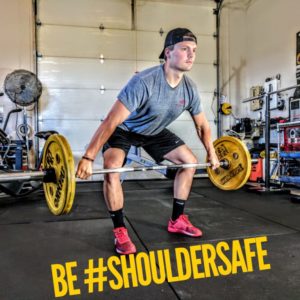One of the most common New Year’s resolutions is getting healthy. Whether it be a diet after the excesses of Christmas or using winter time to get the body summer-fit, many of us flock to the gyms in the new year. Some gym goers, however, manage to either sustain injuries to their shoulder or experience shoulder pain that limits their exercise.
Throughout the year I see several patients in clinic with injuries or pain related to gym activity. I have even experienced shoulder pain during weight lifting and push-ups myself.
What are some of the common gym related shoulder injuries?
Rotator cuff injuries are probably the most common and these may range anywhere from flare-ups of rotator cuff tendinopathy to full thickness rotator cuff tears. While tendiopathy doesn’t require surgical treatment, acute rotator cuff tears often do. Another injury seen from weight lifting is rupture of the pectoralis major tendon which we have discussed in one of our earlier blogs. Injuries to the long head of biceps anchor (SLAP tears) or the labrum (cartillage rim surrounding the shoulder socket) can also occur and in severe cases, with loss of control of extreme weights, shoulder dislocations can occur.
While it is not an injury, a common condition that can affect particularly male weightlifters is distal clavicle osteolysis. This is a panful condiiton where microdamage to the end of the collar bone can cause pain at the top of the shoulder.
What causes gym related shoulder injuries?
There are 4 factors that can lead to shoulder pain or injuries in the gym: excessive loading, repetitive loading, poor technique, and steroids/performance enhancers. There is no doubt, overloading a tendon beyond its structural capability will cause it to rupture. But overloading isn’t just about weight, the direction in which the load is applied, and the rate at which it is applied can also cause tendons to fail. Degenerate tendons are weaker than healthy ones and as we age, our tendons degenerate, so we need to be cautious how we load our tendons as we age.
Repetitive loading can also cause problems for shoulders. Too many repetitions and not enough recovery time can lead to inflammation of the subacromial bursa or flare up of tendinopathy of the rotator cuff tendons or long head of biceps tendon resulting in pain during or after exercise. Poor technique can cause similar problems by loading our tendons in unfavourable directions/positions which can also lead to inflammation and pain.
Steroids and other performance enhancers are known to weaken healthy tendons leading to ruptures, so it is always advised to avoid these.
What can I do to be #ShoulderSafe?
The best way to avoid gym related injuries is to have a sensible routine that increases weight in a safe and realistic manner. Technique is also important, and we can often fall into bad habits and postures that need correcting. I recommend consulting a personal trainer or strength and conditioning coach to develop a safe and realistic plan to meet your goals. Most good gyms offer introductory plans for free. Getting a personal trainer or strength and conditioning coach to show you how to perform exercises especially weight lifting correctly and safely is key, but I would get them to review you from time to time to ensure you aren’t developing bad habits or posture. There is a good research paper highlighting some of the poor techniques that can lead to shoulder injuries and discusses ways to avoid them.
Finally stay away from steroids and performance enhancers if you want to stay away from the surgeon’s blade!
Be #ShoulderSafe!





